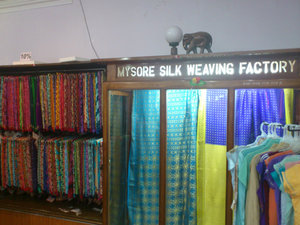Advertisement
Published: January 17th 2013

 Mysore Silk Factory Shop
Mysore Silk Factory Shop
Company is owned by Government and only use silk produced in India.For all those ladies reading this that like to wear silk scarves you might want to brace yourself for the inside story on how this amazing fabric is produced. In the UK we associate the Mulberry with very old bushes as depicted in the traditional nursery rhyme.
Today we were lucky enough to get a guided tour of the Mysore Silk Factory, which is famous for it’s intricate gold and silver woven patterns. It is actually protected with a Geographical Indicator which recognises the unuque product produced in the city and means nobody else can copy the designs.
The factory receives the silk yarn from the farms (more about that later!) and first needs to soak the yarns to remove the saliva from the silk worm who has woven the cocoon. This process is known as “degumming” and can take 3hours of soaking in water heated to 110 degrees centigrade. The chemicals dyes are added after this stage and take 2.5 hours to colour enough yarn for approx. 24 saris.The yarn is first woven by hand and then onto reels with a machine before heading to the loom for weaving.
Genuine gold and silver is woven into the
threads used for the patterns and contain 65%!p(MISSING)recious metals and saris containing these threads can sell for between 11,000 (£125) to 120,000 (£1350) rupees and the material is extremely high quality.
The beautiful thing about silk is that is waterproof, breathable, wrinkle free and even perfumed. The perfect garment for all round wearing! The material is even treated with Scotch Guard to resist stains.
Factory facts: - 250-300 saris produced each day
- Approx. 420,000m per annum
- It takes between 5.5 and 6.3m to make one sari
- Factory produces around 80,000 saris per year
The factory is very safety and environmentally aware – they have a large number of ISO, EMS & Health & Safety standards and also try to conserve energy and water wherever possible. They have managed to save 15%!((MISSING)approx 2-4 tonnes per month) on coal consumption, but installing solar panel hot water heaters. There is fully traceability in the factory with each piece of material being printed with unique ID number which notifies which colour dye was used, which loomed it was woven on and date of production. A specific “100%!P(MISSING)ure Mysore Silk” transfer is also ironed onto
each piece.
The following day Angie and I went to a silk worm farm about 40km east of Mysore accompanied by Harish who is an Agricultural Office with Karnataka State Government. It was very interesting to learn about how the silk worms are cultivated for their valuable threads.
Firstly the silk worm eggs are hatched and then worms are fed on finely chopped mulberry leaves until fully grown. They are reared indoors on large racks and fresh leaves are given every 4-5 hours to encourage growth. When the worms start to turn yellow they are taken outside to special circular woven nest (see photo) where they will start to weave their cocoons after 3-4 days. Unfortunately the beautiful butterflies never get to hatch and the worms are killed before the cocoons are dried, boiled and reeled in the factory. Cocoon yarn is then woven into the fabric of many saris in India and many other clothes across the world.
Silk worm facts - 7.5kg of cocoons converts to 1kg of silk
- 90m of yarn comes from each cocoon
- Factory has capacity to process 20,000kg (20 tonnes) of cocoons each month
Bet you

 Close up of silk worms
Close up of silk worms
These worms have been fed on freshly chopped Mulberry leaves for 10 days and nearly ready to start the cocoon stage once they turn yellow colour.won’t look at a Mulberry bush in quite the same light anymore!!! Hope you've enjoyed reading my latest blog and will be be back again soon!!!
Emily X
Advertisement
Tot: 0.107s; Tpl: 0.009s; cc: 11; qc: 47; dbt: 0.064s; 1; m:domysql w:travelblog (10.17.0.13); sld: 1;
; mem: 1.1mb

 Mysore Silk Factory Shop
Mysore Silk Factory Shop
 Close up of silk worms
Close up of silk worms

Martin Jayne
non-member comment
fascinating stories
really interesting tales from India - life will be just that bit boring in England when you get back, ps snow is forecast for us, but don't let that bother you!